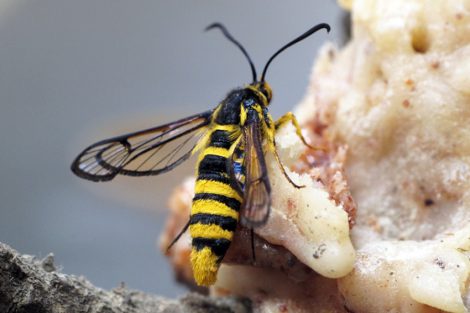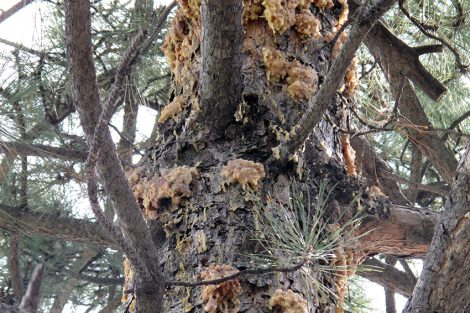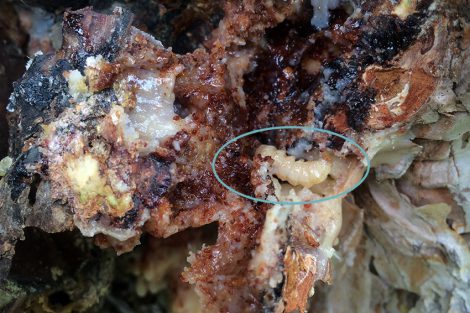In this Issue:
- Honeylocust borer: If positively identified, treat trees now
- Honeylocust pod-gall midge: Protect emerging foliage now
- Lilac-ash borer: Treat susceptible trunks starting 7-10 days after lilac full bloom until mid-July
- Ash leaf-curl aphid: Apply systemic if needed
- Pine pitch mass borer: Apply trunk spray in 2 – 3 weeks
DECIDUOUS TREES
Honeylocust Borer
If positively identified, treat trees starting in early May
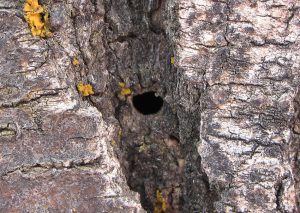
Honeylocust is a widely planted tree that we typically don’t think of as having problems with borers. But in the last few years, trees in the Salt Lake area have been found infested with honeylocust borer (Agrilus difficilus).
Honeylocust borer is a flatheaded (metallic) beetle related to the pacific flatheaded borer, bronze birch borer, and emerald ash borer (which is not in Utah). It only attacks honeylocust, and is not to be confused with the locust borer that only attacks black locust.
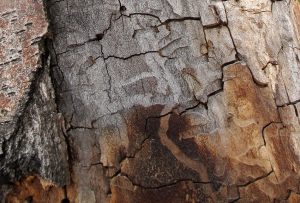
Trees that are under drought stress, or newly planted trees, are the most susceptible. Mature, healthy, and properly planted trees are rarely attacked.
Adults start laying eggs on the bark in early May, and continue for 6 weeks.
Larvae bore into the tree’s cambium where they create shallow, meandering tunnels. Tree sap will ooze out of the entry site and then harden into a frothy mass of gum. Repeated infestations gradually cause decline and dieback of twigs and branches in the crown.
Treatment:
Management relies on prevention. Keep trees healthy with optimal watering and fertilizer so they can withstand attack.
Insecticides should target the adults. Although the larvae of flatheaded borers can be killed by systemics, they should not be used on honeylocusts, as these trees are bee-magnets when in bloom.
- Residential options: Hi-Yield Permethrin, Spectracide Triazicide (lambda-cyhalothrin)
- Commercial options: Acelepryn (chlorantraniliprole), permethrin (Astro, Covert, Waylay), Onyx (bifenthrin)
Honeylocust Pod-gall Midge
Treat foliage newly emerging foliage now if this pest is a problem
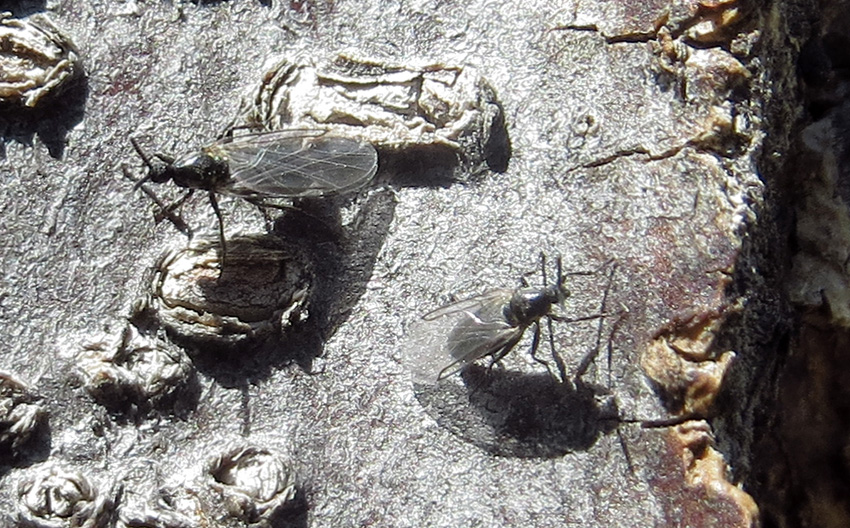
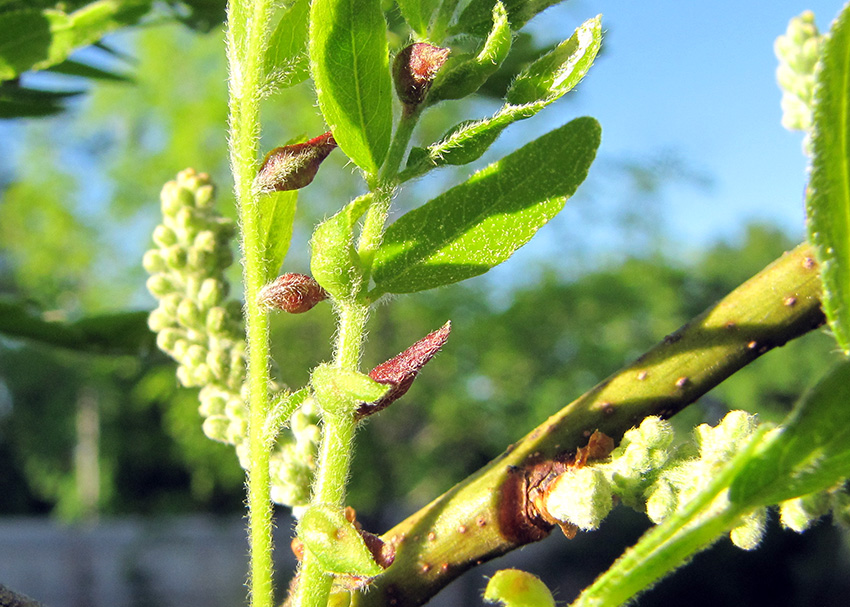
Swellings (galls) on honeylocust leaves are fairly common in northern Utah, and are caused by a midge (Dasineura gleditchiae). The females lay eggs on young honeylocust leaves. When the midge larvae hatch, their feeding causes the leaflets to turn into hollow galls, and each gall may contain one or multiple larvae.
Heavily infested leaves will drop prematurely and new shoots will develop. There are several generations each year.
Treatment:
This pest is usually an aesthetic issue only, and does not require treatment. If necessary, apply an insecticide as the foliage emerges.
- Residential and Commercial: Spray with carbaryl (Sevin) once or use 1% horticultural oil (organic) twice, spaced 2 weeks apart.
Lilac-Ash Borer
Treat susceptible trunks monthly, starting 7-10 days after full bloom of lilac, until mid-July
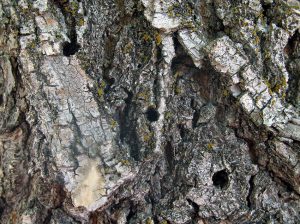
Lilac-ash borer adults are just starting to emerge from infested trees, and females will soon lay eggs on the bark of ash trees and lilac. Green and white ash (Fraxinus) are the most susceptible. Sometimes, mountain-ash (Sorbus) and privet are attacked.
Lilac-ash borer does not directly kill trees, but repeated infestations can cause branch dieback and can leave trees susceptible to breakage in storms. Infested trees will have round exit holes on the bark, sawdust-like frass near the holes or at the base of the tree, and rough, swollen, cracked bark, mostly near branch crotches.
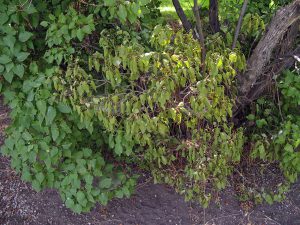
Treatment:
Healthy plants are able to withstand minor infestations, while stressed plants are more susceptible to attack and failure, so give trees optimal water and fertilizer, and prune properly.
Insecticides target the adults. Small trees can be treated by the home gardener, but in order to get thorough coverage on large trees, treatments should be made by a licensed pesticide applicator.
Applications should protect the bark for 6 weeks (usually until mid-July)
- Residential options: Hi-Yield Permethrin, Spectracide Triazicide (lambda-cyhalothrin); spray trunks once/month
- Commercial options: Acelepryn (chlorantraniliprole), permethrin (Astro, Covert, Waylay), or Onyx (bifenthrin)
Ash Leaf-Curl Aphid
Apply systemic insecticide only where needed
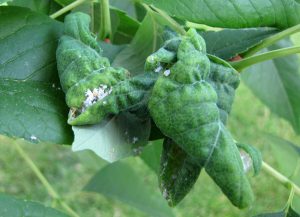
This aphid (Prociphilus fraxinifolii) has a few common names: ash leaf-curl aphid, leafcurl ash aphid, and woolly ash aphid. It overwinters on the roots of ash trees, and in spring, aphids migrate up the trunk to feed on the foliage. When populations are high, aphids fly to adjacent ash trees. The aphids stay on the ash foliage until late summer, when they migrate back down the trunk to the roots.
Aphids that feed on the foliage cause severe twisting and cupping of the leaves, and in severe cases, galling of the leaf tissue. Even though the damage may look extreme, the health of the tree is rarely affected.
Treatment:
- Because the aphid exudes a waxy coating that helps to protect it from predators, and they are hidden in foliage, contact sprays are not effective.
- One of the few options is a systemic application of imidacloprid in spring (brands available for both commercial and residential).
CONIFERS
Pine Pitch Mass Borer
Treat trunks of pines in the next few weeks
The Sequoia pitch moth (Synanthedon sequoiae) is a clearwing moth whose larvae feed on the outer and inner bark of pine trees. Their feeding stimulates the tree to produce copious sap that forms large, drippy masses on the trunk. The larvae will also feed within the mass of pitch and if you remove the glob at the right time, you will often find a larva inside or close to the trunk.
From May through August, adult moths lay eggs on bark, often preferring pruning or other wounds, branch collars, or existing pitch masses. When the eggs hatch, the larvae bore through the bark and create meandering tunnels in the cambium, or may bore into the sapwood. The feeding is usually localized around the pitch mass, and sometimes, the larvae will exit the wood and feed on the pitch.
Smaller trees are at greatest risk of being affected by pitch mass borers. Larger, healthy trees can withstand attack.
Keep in mind that after the moths exit the trees, the pitch mass will remain on the trunk, possibly for several years, unless they are removed by hand.
Treatment:
Management should focus on keeping trees healthy. Avoid pruning in July when moths are laying eggs. Manually remove existing pitch masses to prevent further egg-laying or to kill larvae inside. If a spray is warranted on larger trees, it should be applied by a professional.
- Commercial: permethrin or bifenthrin (trunk sprays); start application in early to mid May, so that trunks are protected through early August

